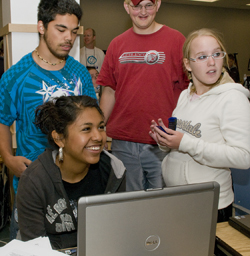About the CBI
The AccessSTEM Capacity Building Institute (CBI) took place April 27, 2009, in Seattle. Its overall purpose was to explore ways to increase the participation of people with disabilities in all science, technology, engineering, and mathematics (STEM) projects, academic programs, and, ultimately, careers. A particular focus was on potential interventions for high schools, community colleges, and two-year schools in and near Seattle.

Participants in this half-day event included AccessSTEM project leadership and key staff, core stakeholder groups, and representatives from NSF. Hosted at the University of Washington, the AccessSTEM CBI provided a forum for sharing successful practices, reporting research results, developing collaborations, and otherwise increasing the capacity of all NSF-funded projects to serve individuals with disabilities.
The goal of the AccessSTEM CBI was to share AccessSTEM project objectives and progress and to brainstorm ideas for future collaborations and activities. Broad issue areas discussed included:
- barriers to STEM for students with disabilities
- lessons learned in previous DO-IT (Disabilities, Opportunities, Internetworking, and Technology) projects
- results from DO-IT's longitudinal transition study (ALTS)
In this CBI:
- All participants were actively engaged.
- Participants didn't just present predetermined professional development content; they requested and offered content as the meeting evolved.
- Participants explored ways to build capacity to reach the goal of the Institute, within their project organizations and beyond.
The AccessSTEM CBI began with presentations about the AccessSTEM project by project leadership and NSF staff. Following these presentations, small groups worked to answer the following question:
- What are specific things that project partners (Seattle Public Schools, Seattle Community Colleges, Bellevue College, and University of Washington) can do in 2009–2010 to increase the participation of students with disabilities in science, technology, engineering, and mathematics?
Group representatives reported to all participants and notes were incorporated into the proceedings. The results of these efforts are shared online at Event Proceedings.